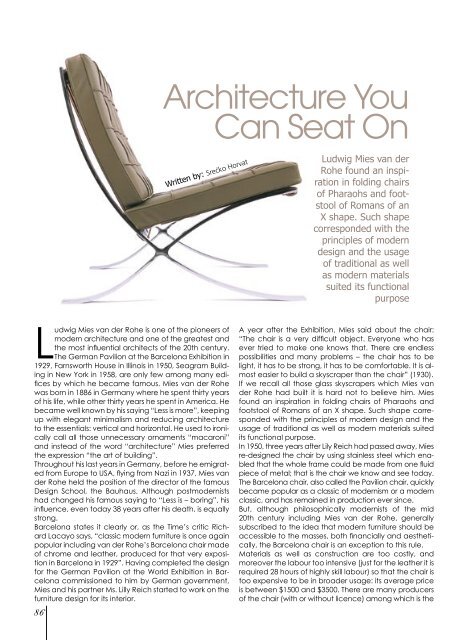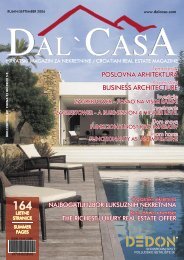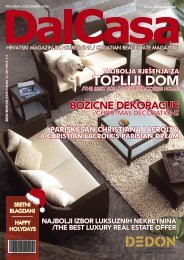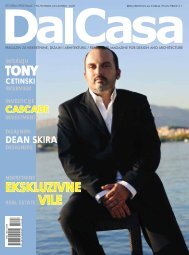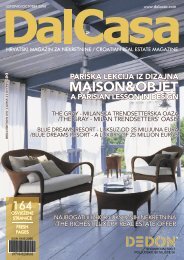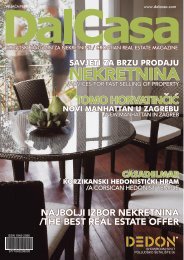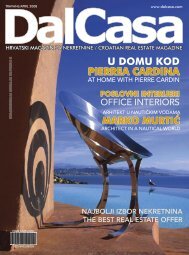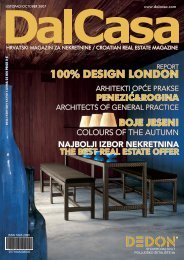turistiÄki procvat zelene istre - DalCasa
turistiÄki procvat zelene istre - DalCasa
turistiÄki procvat zelene istre - DalCasa
You also want an ePaper? Increase the reach of your titles
YUMPU automatically turns print PDFs into web optimized ePapers that Google loves.
Architecture You<br />
Can Seat On<br />
Written by: Sreæko Horvat<br />
Ludwig Mies van der<br />
Rohe found an inspiration<br />
in folding chairs<br />
of Pharaohs and footstool<br />
of Romans of an<br />
X shape. Such shape<br />
corresponded with the<br />
principles of modern<br />
design and the usage<br />
of traditional as well<br />
as modern materials<br />
suited its functional<br />
purpose<br />
Ludwig Mies van der Rohe is one of the pioneers of<br />
modern architecture and one of the greatest and<br />
the most influential architects of the 20th century.<br />
The German Pavilion at the Barcelona Exhibition in<br />
1929, Farnsworth House in Illinois in 1950, Seagram Building<br />
in New York in 1958, are only few among many edifices<br />
by which he became famous. Mies van der Rohe<br />
was born in 1886 in Germany where he spent thirty years<br />
of his life, while other thirty years he spent in America. He<br />
became well known by his saying “Less is more”, keeping<br />
up with elegant minimalism and reducing architecture<br />
to the essentials: vertical and horizontal. He used to ironically<br />
call all those unnecessary ornaments “macaroni”<br />
and instead of the word “architecture” Mies preferred<br />
the expression “the art of building”.<br />
Throughout his last years in Germany, before he emigrated<br />
from Europe to USA, flying from Nazi in 1937, Mies van<br />
der Rohe held the position of the director of the famous<br />
Design School, the Bauhaus. Although postmodernists<br />
had changed his famous saying to “Less is – boring”, his<br />
influence, even today 38 years after his death, is equally<br />
strong.<br />
Barcelona states it clearly or, as the Time’s critic Richard<br />
Lacayo says, “classic modern furniture is once again<br />
popular including van der Rohe’s Barcelona chair made<br />
of chrome and leather, produced for that very exposition<br />
in Barcelona in 1929”. Having completed the design<br />
for the German Pavilion at the World Exhibition in Barcelona<br />
commissioned to him by German government,<br />
Mies and his partner Ms. Lilly Reich started to work on the<br />
furniture design for its interior.<br />
86<br />
A year after the Exhibition, Mies said about the chair:<br />
“The chair is a very difficult object. Everyone who has<br />
ever tried to make one knows that. There are endless<br />
possibilities and many problems – the chair has to be<br />
light, it has to be strong, it has to be comfortable. It is almost<br />
easier to build a skyscraper than the chair” (1930).<br />
If we recall all those glass skyscrapers which Mies van<br />
der Rohe had built it is hard not to believe him. Mies<br />
found an inspiration in folding chairs of Pharaohs and<br />
footstool of Romans of an X shape. Such shape corresponded<br />
with the principles of modern design and the<br />
usage of traditional as well as modern materials suited<br />
its functional purpose.<br />
In 1950, three years after Lily Reich had passed away, Mies<br />
re-designed the chair by using stainless steel which enabled<br />
that the whole frame could be made from one fluid<br />
piece of metal; that is the chair we know and see today.<br />
The Barcelona chair, also called the Pavilion chair, quickly<br />
became popular as a classic of modernism or a modern<br />
classic, and has remained in production ever since.<br />
But, although philosophically modernists of the mid<br />
20th century including Mies van der Rohe, generally<br />
subscribed to the idea that modern furniture should be<br />
accessible to the masses, both financially and aesthetically,<br />
the Barcelona chair is an exception to this rule.<br />
Materials as well as construction are too costly, and<br />
moreover the labour too intensive (just for the leather it is<br />
required 28 hours of highly skill labour) so that the chair is<br />
too expensive to be in broader usage: its average price<br />
is between $1500 and $3500. There are many producers<br />
of the chair (with or without licence) among which is the


